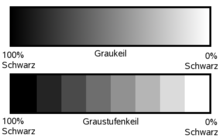Gray wedge
The gray wedge is an aid in optical reproduction , which usually in the form of an elongated strip of film or paper shows the gray gradations between the brightness or density values black and white as a gradient. It is used to obtain a calibration device with which the different recording and playback capabilities of different optical devices can be assessed or coordinated with one another.
A simple reproduction of the original is sufficient for the assessment, by means of which it is determined by comparison which gradations can still be distinguished and which cannot. For coordination purposes, an original of the gray wedge is sent as an image ( e.g. negative or scan) through the individual processing steps so that the output (reproduction, print, photo print) corresponds as closely as possible to the original. If the parameters determined in this way for the individual processing steps are now retained when processing other objects, a defined result of the brightness reproduction can be expected.
The most commonly used shape is the grayscale wedge, which is part of the standardized IT8 chart designed by Kodak . The area between black and white is not an “analog” gradient, but is divided into 22 levels with increasing gray values. Many better devices for image editing and processing such as digital cameras , scanners or screens come with such a chart, or you can get one from specialist photo shops.
Another application of the gray wedge is found in optical spectrometers , where it is used to continuously adjust the beam intensity.
Web links
To check the monitor:
